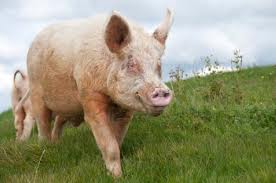
|
Harmony and Luckiness Imp.&Exp. Co., Ltd. |
|
|||
Products Category |
Swine-Large WhiteProduct name : Swine-Large White Item : P-01 Details :The Large White, also known as the English Large White, is a breed of domestic pig originating in Yorkshire, hence also known as the Yorkshire pig. First recognized in 1868, the breed is the progenitor of the American Yorkshire (or simply Yorkshire) in North America.[1] The Large White is one of the most numerous of all pig breeds, widely used in crossbreeding for intensive pig farming around the world. True to its name the breed is a big white-skinned pig, with erect ears and a dished face. It was originally developed as an outdoor breed, but today it is one of those favored by commercial pig breeders, lending uniformity to pigs produced for meat on a large scale. There were 3,990 Large White swine registered in England in 1981, ranking them as the top breed of their native country. Furthermore, it is easily the leading breed of the world if one considers that swine called Yorkshires in the United States and Canada are the direct descendants of the Large White. Virtually every country in the world that values swine has made importations of the Large White. The extent of importation seems to reflect the importance placed on swine production by the various countries. Large Whites are distinguished by their picturesque bearing, erect ears, slightly dished faces, white color, pink skins, and long deep sides. They have been valued for their bacon production since the inception of the breed. As their name suggests, they are characterized by large size. The breed originated in Yorkshire County, England, but the history is difficult to trace. The large, coarse-boned and leggy white pigs of the region were crossed with other breeds. Davidson, in The Production and Marketing of Pigs, has suggested that among these were the Cumberland, Leicestershire, and the Middle and Small White. Specimens of the new breed first attracted attention at the Windsor Royal Show in 1831. The stock used in the development and improvement of the pigs of that area is not as important as what was finally produced as a breed. The Large White has since become a well established and prepotent breed which has truly left its mark on world swine production. It is found throughout its native country of England and is also popular in Northern Ireland. The Large White is regarded as a rugged and hardy breed that can withstand variations in climate and other environmental factors. Their ability to cross with and improve other breeds has truly made them a factor nearly everywhere commercial swine are produced. They have been known for decades as a favorite market animal where high quality bacon and pork are sought. Their tendency to grow and not lay down excess fat have made them favorites, not only when swine are marketed at relatively light weights, but also when they are carried to heavier weights. Large Whites are known for large litters, heavy milk production and for having excellent maternal instincts. They are not only lean and active, but are also quite sound in feet and legs. They carry their considerable length with ease and grace. Their extra height, or length of leg, helps them to remain active and have long useful lives in the breeding pen.
Husbandry
The breed is extremely adaptable with a high ability to flourish, grow, produce and reproduce in irregular and low rainfall environments. Dorpers are known to adapt well to feed lot condition which offers farmers an alternative method to finish lambs in times of drought. The breed is regarded as having the ability to graze and browse which suggests it will consume plants seldom eaten by the Merino. Send Inquiry : |
Copyright © 2026 Harmony and Luckiness Imp.&Exp. Co., Ltd. All Rights Reserved







 Cattle
Cattle  Swine
Swine 

